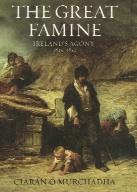The Great Famine: Ireland’s agony, 1845–1852 Ciarán Ó Murchadha (Continuum, €16) ISBN 9781847252173
Published in 18th-19th Century Social Perspectives, 18th–19th - Century History, Book Reviews, Issue 3 (May/June 2012), Reviews, The Famine, Volume 20
The Great Famine: Ireland’s agony, 1845–1852
Ciarán Ó Murchadha
(Continuum, €16)
ISBN 9781847252173
On 15 June 1843, huge crowds congregated on a racecourse outside Ennis at a ‘monster meeting’ in support of the repeal of the Act of Union. Adhering to a template, the mass rally of rousing speeches was followed by a magnificent evening banquet in the town’s old chapel, where Daniel O’Connell compared the momentum of the Repeal cause to a ‘mighty avalanche in the Alps’ that ‘destroys the blooming and fertile villages and makes one gigantic convulsion of all’. After painting a captivating portrait of the choreography of the day, from the Liberator’s ceremonial procession along the town’s decorated streets through to the green and crimson canopy framing the banquet’s illustrious guests, Ciarán Ó Murchadha delivers a harrowing denouement: by 1848 tens of thousands of those who had gathered on the Ennis racecourse on that warm summer day would be dead of starvation or disease, lying half-starved in workhouses, violently evicted from their land or forced from their homeland. O’Connell was dead and, in a twisted irony, his evocative imagery at the banquet ominously anticipated the catastrophic vistas of Famine Ireland. The prologue to The Great Famine encapsulates the book: microscopic detail is painstakingly assembled to propel a compelling narrative sweep. Systematically charting the destruction of the potato harvests, the degradation inflicted by the relief programmes, the swell of fever pandemics through the workhouses, the mass clearances and the haemorrhaging emigration, The Great Famine closes with a sober analysis of the underlying causes and consequences of this watershed moment in Irish history. Shortlisted for the Longman/History Today ‘Book of the Year’ award, The Great Famine integrates the prodigious Famine scholarship of the last twenty years, drawing extensively on accomplished local studies, to provide a comprehensive record of the Famine across the entire country. The importance of this corpus of regional histories is close to the author’s heart: Ó Murchadha’s 1998 Sable wings over the land scrupulously chronicled the unfolding of the Famine in County Clare. As though to underline the centrality of the devastating eyewitness accounts that suffuse this book, each chapter begins with a contemporary quotation. Diary entries, letters and newspaper reports eloquently attest to the apocalyptic episodes wrought by the catastrophe. In Skibbereen Nicholas Cummins describes being surrounded by 200 ‘frightful spectres’; in west Clare a reporter writes that the locals ‘died as the birds do when the frost comes’, while on a ‘coffin ship’ passengers ‘huddled together without light, without air, wallowing in filth and breathing a fetid atmosphere’. Ó Murchadha asserts that the arrival of the Whig-Liberal government of Lord John Russell—and a cabinet heavily influenced by Christian providentialism and political economy—during the recurrence of the blight in 1846 was ‘to the profoundest misfortune of the Irish poor’. By March 1847, public works were at their peak—employing over 700,000 and supporting over three million—in an exercise that underlined the lengths to which a government would go rather than feed the starving. Their sudden closure and replacement by a network of soup kitchens was an ‘ideological volte face’ and a ‘tacit admission of abysmal failure’. Ironically, the relief measures of public works, soup kitchens and workhouses facilitated the spread of fever epidemics that accentuated mass death.Between 1845 and 1855 a quarter of the population—over two million—emigrated in an exodus with ‘no other nineteenth century parallel’. Over 95% of those who left travelled across the Atlantic, and approximately 80,000 died during passage. For most, fleeing the Famine and surviving the crossing was just the beginning: their nationality and Catholicism engendered hostility among the natives, and their lives would revolve around ‘work-slavery, psychological alienation and the alcohol with which many sought to obtain relief from both’. Two failures are isolated as central to the Famine: private charity and state relief. While contributions were received from the likes of the US president and the papacy, the effort was tempered by, among other factors, rocketing international food prices. Britain spent £8 million on relief programmes in Ireland during the Famine; it spent £69 million on the Crimean War (1854–6).Whig-Liberal ideological inflexibility is cited as a mask for deep-seated anti-Irish racism, while the assumption among the political élite that the Famine presented an opportunity to reform Ireland is seen as echoing the policies underpinning the Tudor and Stewart plantations. The author asks whether the price the government was prepared to pay for the nineteenth-century experiment is reflected in the 1851 Irish census report, where the commissioners note that, despite a drop from 8.2 million in 1841 to 6.5 million, the results ‘are, on the whole, so satisfactory, demonstrating as they do the general advancement of the country’. The contentious issue of responsibility is examined but would benefit from a fuller discussion. Replete with startling contemporary images and almost unbearably vivid first-hand accounts, The Great Famine is a succinct, accessible and compassionate history—for scholars and the general reader—informed by an imaginative approach: Ó Murchadha identifies the first and last victims of starvation in the country, for example, and considers the significance of the births of Davitt, Parnell and Cusack at the height of the Famine. You don’t doubt the author when he writes that, even at this remove, it is ‘almost impossible to comprehend in its totality … the evidence left by this calamitous period, in its vastness and in its minute detail alike’. HI
Brendan Daly is a freelance journalist and writer.
















